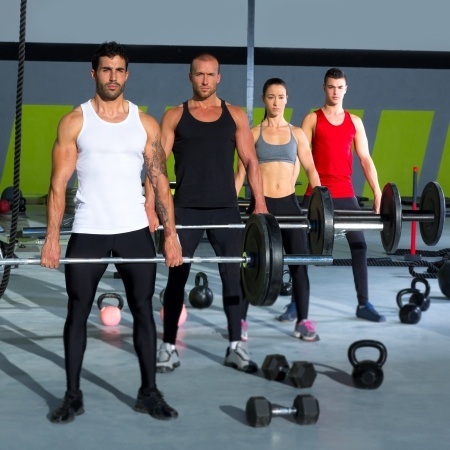Straight Barbell Rows are a staple movement to develop maximum pulling strength and core stability.
Emphasis
The primary muscles stressed in this movement are the muscles in your upper back (latissimus dorsi and rhomboids). The secondary muscles stressed are the biceps, lower back and shoulders.
Starting Positions
Grip a weighted bar with your arms extended and bar at thighs. Carefully hinge forward at the hips, knees slightly bent. Push your chest out and pull your shoulders back. Your back should be straight and near parallel to the floor.
Movement
Pull the bar up to the rib cage and squeeze your shoulder blades together. Take 2-3 seconds to lower the bar back to the extended position.
Training Tips
- Keep your chest out and your shoulders back to help isolate the back muscles.
- Be sure to focus on pulling the bar up to your chest trying not to use your arms.
Options
- There are two techniques you can use to target different areas of the back:
- Hand position can be varied (wide, medium, close, and under)
- The area of the chest where you bring the bar down to can be varied
Warning Tips
- Do not overextend your shoulders as you lower the bar. Failure to do so can result in serious injury to your shoulders.
- Do not round your back during this movement. Failure to do so can result in serious injury to your back.
- Do not raise your upper body up and down as you raise the bar. Failure to do so can result in serious injury to your back.
- Do not lower the bard down to the extended position any faster than 2-3 seconds. You must be in control at all times during this movement. The faster you perform this movement, the less control you will have, which in turn will increase your risk of injury.
- Do not straighten your knees during this movement. Failure to do so can result in serious injury to your lower back.
Robert Bovee Certified Master PPT, RTS, ETS, FTS
As one of the most successful Professional Personal Trainers and Exercise/Fitness Therapists in the United States, Robert continues to remain at the forefront of the industry by providing his clients with a thorough education and the tools to implement that education. By improving his client’s physical health, strength, endurance, cardiovascular fitness and nutritional habits, he is able to motivate them to lead longer, happier and more productive lives. Find out more about Robert and his personal training career and services, here.
Guest authors offer experience and educational insights based on their specific area of expertise. These authors are contributing writers for the NFPT blog because they have valuable information to share with NFPT-CPTs and the fitness community at-large. If you are interested in contributing to the NFPT blog as a guest, please send us a note expressing your interest and tell us how you can contribute valuable insights to our readers. We look forward to hearing from you! Send to editor@nfpt.com

